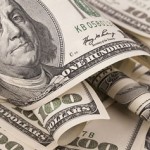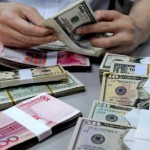Dollar Holds Longest Yen Gains After U.S. GDP

The dollar headed for its biggest monthly gain versus the euro since February last year as signs the U.S. economy is strengthening spurred traders to boost predictions for higher Federal Reserve rates.
The U.S. currency has risen versus all except one of its 16 major counterparts in July as reports have shown gross domestic product rebounded and durable goods orders increased. Economists predict data tomorrow will show U.S. employers added more than 200,000 jobs for a sixth month. Australia’s dollar fell toward an eight-week low after building approvals unexpectedly declined. India’s rupee weakened on concern capital inflows to emerging markets will slow as the Fed cuts bond purchases.
“The signs are there that a stronger U.S. dollar trend is emerging,” said Sean Callow, a Sydney-based strategist at Westpac Banking Corp. “The combination of the upside surprise in GDP and a Fed that admits that the economy is looking healthier provides a useful source of fuel for the U.S. dollar near term.”
The dollar was unchanged at $1.3397 per euro at 7:02 a.m. in London, having advanced 2.2 percent this month. It appreciated to $1.3367 yesterday, the strongest since Nov. 12. The U.S. currency traded at 102.73 yen from 102.79 yesterday after gaining for the previous nine trading days. The euro was little changed at 137.65 yen.
Job Growth
U.S. employers added 231,000 workers in July and the jobless rate stayed at an almost six-year low of 6.1 percent, according to Bloomberg News surveys before tomorrow’s Labor Department data. The world’s biggest economy expanded at a 4 percent annualized pace last quarter, after shrinking 2.1 percent in the previous three months, the Commerce Department said yesterday.
The dollar will strengthen 2.2 percent to 105 yen by year-end, according to the median forecast of more than 60 analysts surveyed by Bloomberg.
“Our view is range bound to dollar-yen near term but ending the year strong at around 106, 107,” Callum Henderson, global head of foreign-exchange research at Standard Chartered Plc in Singapore, said today in a Bloomberg Television interview. “Dollar-yen is more of a function of U.S. data right now than Japanese data.”
The Bloomberg Dollar Spot Index, which tracks the U.S. currency against 10 major counterparts, was little changed today at 1,020.32, having climbed 1.7 percent in July, set for the best month since May 2013.
Fed Tapering
Fed officials cut monthly bond buying to $25 billion at a two-day meeting that finished yesterday, staying on pace to end the program in October. Traders see 87 percent odds the central bank will raise the target for its benchmark rate to at least 0.5 percent by September 2015, based on futures contracts. The figure was 78 percent at the start of July.
Australia’s dollar weakened versus 13 of its 16 major peers after the Bureau of Statistics said building approvals fell 5 percent in June. Economists surveyed by Bloomberg estimated they would be unchanged.
The Aussie dropped 0.1 percent to 93.24 U.S. cents after sliding to 93.04 cents yesterday, the weakest since June 5. The currency has declined 1.2 percent in July, set for the first monthly loss since January.
The rupee fell the most in three weeks on speculation the conclusion of the Fed’s bond purchases will curtail demand for emerging-market assets.
“The markets are a little jittery on concerns inflows will get impacted as the Fed’s bond purchases end later this year,” said Anindya Banerjee, a currency analyst at Kotak Securities Ltd. in Mumbai. “The rupee’s weakness is mainly driven by U.S. economic data last night and the Fed’s decision to further cut bond purchases.”
The rupee fell 0.3 percent to 60.26 per dollar, the biggest one-day decline since July 10.
Source: Bloomberg



























